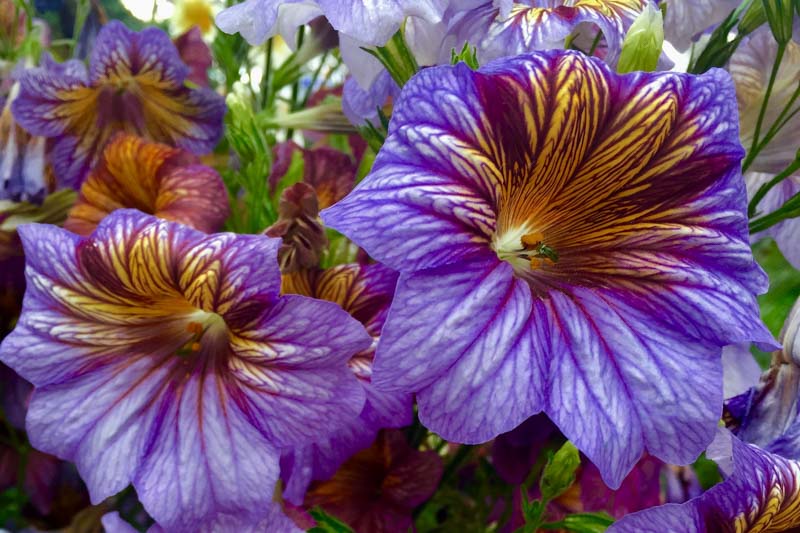Painted Tongue, Scalloped Tube Tongue, Velvet Trumpet Flower
Salpiglossis sinuata, commonly known as Scalloped Tube Tongue or Painted Tongue, is an annual flowering plant recognized for its intricate, velvety blooms.
Native: This plant is native to southern Chile.
Plant Type and Habit: Painted Tongue is an herbaceous annual with an upright growth habit. It’s often grown for its striking flowers.
Size: The plant typically reaches a height of 18-30 inches (45-75 cm) and spreads about 12-18 inches (30-45 cm) wide.
Flowers: Resembling petunia, the flowers feature velvety, trumpet-shaped blooms, about 2 inches across (5 cm), in deep hues like purple, red, and orange, often adorned with striking, contrasting veins.
Bloom Time: The flowering period for Painted Tongue is generally from late spring to early autumn.
Foliage: The plant has lance-shaped, medium-green leaves that are lightly hairy and can be up to 6 inches (15 cm) long.
Hardiness: This is a tender annual, suitable for USDA zones 2-11. It is frost-sensitive and prefers moderate climates.
Award: Winner of the prestigious Award of Garden Merit of the Royal Horticultural Society for its noteworthy qualities.
Uses: Given its ornamental value, it’s primarily used in gardens for visual interest, particularly in flower beds, borders, and containers. These flowers are excellent for cutting gardens.
Wildlife: The plant attracts pollinators like bees and butterflies.
Toxicity: There’s limited information on its toxicity, but it’s generally considered non-toxic to humans and pets.
Invasiveness: Salpiglossis sinuata is not known to be invasive.
Painted Tongue offers a kaleidoscope of colors and patterns, making it a captivating addition to any garden. Its moderate care requirements and adaptability to various growing conditions also make it an excellent choice for both novice and experienced gardeners alike.

Growing and caring for Painted Tongue Flowers can be a rewarding endeavor if you’re looking for blooms that offer vibrant colors and intricate patterns. Here’s how to care for them:
Common problems encountered while growing Painted Tongue (Salpiglossis sinuata) include:
To manage these issues, it’s essential to maintain proper watering, good air circulation, and appropriate fertilization. Pesticides and fungicides can be used if the infestation or disease becomes severe.
| Hardiness |
2 - 11 |
|---|---|
| Climate Zones | 1, 1A, 1B, 2, 2A, 2B, 3, 3A, 3B, 4, 5, 6, 7, 8, 9, 10, 11, 12, 13, 14, 15, 16, 17, 18, 19, 20, 21, 22, 23, 24 |
| Plant Type | Annuals |
| Plant Family | Solanaceae |
| Exposure | Full Sun |
| Season of Interest |
Spring (Late) Summer (Early, Mid, Late) Fall |
| Height |
1' - 3' (30cm - 90cm) |
| Spread |
1' - 2' (30cm - 60cm) |
| Spacing |
12" - 18" (30cm - 50cm) |
| Maintenance | Low |
| Water Needs | Average |
| Soil Type | Chalk, Clay, Loam, Sand |
| Soil pH | Acid, Alkaline, Neutral |
| Soil Drainage | Moist but Well-Drained |
| Characteristics | Showy, Cut Flowers |
| Attracts | Bees, Butterflies |
| Garden Uses | Beds And Borders, Patio And Containers |
| Garden Styles | Informal and Cottage, Cutting Garden, City and Courtyard |
| Hardiness |
2 - 11 |
|---|---|
| Climate Zones | 1, 1A, 1B, 2, 2A, 2B, 3, 3A, 3B, 4, 5, 6, 7, 8, 9, 10, 11, 12, 13, 14, 15, 16, 17, 18, 19, 20, 21, 22, 23, 24 |
| Plant Type | Annuals |
| Plant Family | Solanaceae |
| Exposure | Full Sun |
| Season of Interest |
Spring (Late) Summer (Early, Mid, Late) Fall |
| Height |
1' - 3' (30cm - 90cm) |
| Spread |
1' - 2' (30cm - 60cm) |
| Spacing |
12" - 18" (30cm - 50cm) |
| Maintenance | Low |
| Water Needs | Average |
| Soil Type | Chalk, Clay, Loam, Sand |
| Soil pH | Acid, Alkaline, Neutral |
| Soil Drainage | Moist but Well-Drained |
| Characteristics | Showy, Cut Flowers |
| Attracts | Bees, Butterflies |
| Garden Uses | Beds And Borders, Patio And Containers |
| Garden Styles | Informal and Cottage, Cutting Garden, City and Courtyard |
How many Salpiglossis sinuata (Painted Tongue) do I need for my garden?
| Plant | Quantity | |
|---|---|---|
| Salpiglossis sinuata (Painted Tongue) | N/A | Buy Plants |
Create a membership account to save your garden designs and to view them on any device.
Becoming a contributing member of Gardenia is easy and can be done in just a few minutes. If you provide us with your name, email address and the payment of a modest $25 annual membership fee, you will become a full member, enabling you to design and save up to 25 of your garden design ideas.
Join now and start creating your dream garden!
Create a membership account to save your garden designs and to view them on any device.
Becoming a contributing member of Gardenia is easy and can be done in just a few minutes. If you provide us with your name, email address and the payment of a modest $25 annual membership fee, you will become a full member, enabling you to design and save up to 25 of your garden design ideas.
Join now and start creating your dream garden!